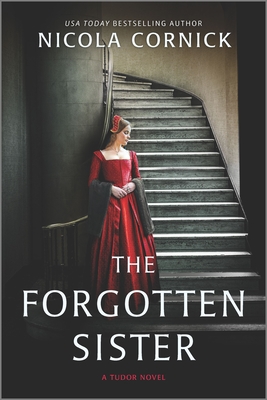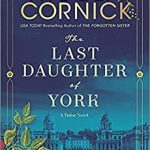 The Forgotten Sister by Nicola Cornick
The Forgotten Sister by Nicola Cornick Format: eARC
Source: supplied by publisher via Edelweiss
Formats available: paperback, ebook, audiobook
Genres: historical fiction, timeslip fiction
Pages: 368
Published by Graydon House on November 10, 2020
Purchasing Info: Author's Website, Publisher's Website, Amazon, Barnes & Noble, Kobo, Bookshop.org
Goodreads
In the tradition of the spellbinding historical novels of Philippa Gregory and Kate Morton comes a stunning story based on a real-life Tudor mystery, and of a curse that echoes through the centuries and shapes two women’s destinies…
1560: Amy Robsart is trapped in a loveless marriage to Robert Dudley, a member of the court of Queen Elizabeth I. Surrounded by enemies and with nowhere left to turn, Amy hatches a desperate scheme to escape—one with devastating consequences that will echo through the centuries…
Present Day: When Lizzie Kingdom is forced to withdraw from the public eye in a blaze of scandal, it seems her life is over. But she’s about to encounter a young man, Johnny Robsart, whose fate will interlace with hers in the most unexpected of ways. For Johnny is certain that Lizzie is linked to a terrible secret dating back to Tudor times. If Lizzie is brave enough to go in search of the truth, then what she discovers will change the course of their lives forever.
My Review:
The fate of Amy Robsart has been one of those long-standing historical questions, to the point where the mystery of whether it was accident, suicide or murder was one of the historical mysteries presented to Inspector Alan Grant at the beginning of The Daughter of Time. While he decided to investigate the “Princes in the Tower”, the question of Amy Robsart is still an interesting one, because of the way that it ties back to a towering figure of English history, Queen Elizabeth I.
Whether the “Virgin Queen” really wanted to marry her Master of Horse, Robert Dudley, or not, the questions that surrounded his wife’s death pushed that possibility forever out of reach. But it’s easy to get caught up in the alternate paths of history. If Dudley and Elizabeth had married, would she still have managed to become the legendary Gloriana? Would they have had children? How much different would history be if Elizabeth had a child of her own to follow her on the throne, instead of the endless plots of Mary, Queen of Scots and the English throne passing to HER son, James VI of Scotland who became James I of England.
There might have been no King James’ Bible. The Stuarts would never have come to the throne, which means that the Hanovers would never have followed them. If there was no George III, there would have been no American Revolution.
Now there’s a fascinating idea, and just the kind of rabbit hole that alternate history stories love to go down. But that’s not what happens in this story.
The story of The Forgotten Sister is kind of a time slip story that provides illumination on that long-ago mystery but doesn’t change the outcome.
In the 21st century, Lizzie Kingdom and Dudley Lester have been friends since childhood. They are also A-List celebrities. What they aren’t is married to each other. Nor do they seem to have any desire to be. Rather, Dudley is married to Amelia Robsart, while he spends a great deal of time palling around London and partying with his best friend Lizzie.
To the point where Amelia Lester feels neglected, only because she is – gets depressed, only because her life is depressing – and falls down a flight of marble stairs. At her home, Oakhanger, which was constructed using the stones from Cunmor, where, guess what? Amy Robsart fell down a marble staircase and died in 1560, neglected and depressed because everyone knew her husband was off cavorting with Elizabeth Tudor while she was forced to rusticate in the country.
The parallels between Amelia Robsart’s fate in the 21st century and Amy Robsart’s fate in the 16th are filled with similarities and congruences to the point where we think we know what happened both times around – and that the same things happened both times around. And we kind of do.
But we kind of don’t.
Because the 16th century part of this story may be told from Amy Robsart’s point of view, but the 21st century perspective is not Amelia’s. Instead, we see the events in the 21st century through the eyes of Lizzie Kingdom. A woman who, like her 16th century avatar, is determined to finally seize the reins of her own life, but someone who has an entirely different set of options.
If she can just get out from under the accessory to murder charge she’s currently saddled with – along with the fleet of managers and assistants and toadies who are determined to keep her under glass and under their control – so they can continue to drain her dry.
Escape Rating B+: One of the things I wondered about as I read this was whether it worked better if you knew the history – or if it worked better if you didn’t and everything was a revelation. This was history I knew and knew well, so the parallels were easy to spot – although the way the author twisted Amy/Amelia’s story was fascinating. Historically perhaps not plausible, but not completely implausible either.
The one problem with knowing the history was that while the name parallels mostly worked pretty well, the idea that anyone had named their child Letty Knollys in the late 20th century was almost a bridge too far. The congruences didn’t need to be THAT on the nose to work.
That being said, what makes this story work is that the 21st century protagonist isn’t Amelia but rather Lizzie. And that the similarities between Lizzie’s life – and especially Lizzie’s choices – and those of OMG Elizabeth I are less direct equivalences and more of a looser connection. Although it was inspired to think that the closest match to the life of a royal in the 16th century was that of an A-Lister in the 21st. And it so works.
But the story works because as much as the Amy/Amelia Robsart deaths turn out to be history repeating itself, what we see in Lizzie is her breaking out of the bubble she’s been living in, breaking away from the sycophants who are actually controlling her, and finally making a life of her own and making her own choices and taking her own chances. She’s in her late 20s, money seems to be no object, she can afford to take a chance – at least once the murder is solved – and search for a life that has meaning for her rather than a life that makes money for everybody else.
The bits of paranormal woo-woo that serve as kind of the glue between the two time streams are done once-over-lightly in a way that makes them part of Lizzie’s taking charge of her own life as well as part of the ultimate resolution to the timestream. It was just right and just enough and made the ending just lovely.





















Cornick can be hit or miss for me, but I’d like to try this one. I read a lot of Tudor historical fiction back in the day so the mystery is particularly appealing.
(Um, did you really mean to use “fluffer,” or am I totally going down the wrong path? Feel free to delete this if I’m being inappropriate.)
I did mean to say “fluffer”, as in fluffing their egos, giving them ego-boo, making them feel important. I suspect there’s a better word for it, but I wasn’t finding one. So yes, “fluffer”.
and now I’m kind of appalled, wondering what you thought I might have meant!
Marlene Harris recently posted..Review: The Forgotten Sister by Nicola Cornick
Don’t Google it, then. I apparently consort with the wrong class of people. LOL.
OMG! I think I’d better edit that. It reminds of a time when a co-worker was throwing around the word “schmuck” willy-nilly. Pun definitely intended. It was obvious she had no idea what the word meant. OY!
Marlene Harris recently posted..Review: The Factory Witches of Lowell by C.S. Malerich